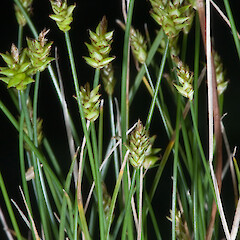Carex capillacea
Common name
sedge
Synonyms
Carex rara subsp. capillacea (Boott) Kük., C. wallii Petrie
Family
Cyperaceae
Flora category
Vascular – Native
Endemic taxon
No
Endemic genus
No
Endemic family
No
Structural class
Sedges
NVS code
The National Vegetation Survey (NVS) Databank is a physical archive and electronic databank containing records of over 94,000 vegetation survey plots - including data from over 19,000 permanent plots. NVS maintains a standard set of species code abbreviations that correspond to standard scientific plant names from the Ngä Tipu o Aotearoa - New Zealand Plants database.
CARCAP
Chromosome number
2n = c.60
Current conservation status
The conservation status of all known New Zealand vascular plant taxa at the rank of species and below were reassessed in 2017 using the New Zealand Threat Classification System (NZTCS) – more information about this can be found on the NZTCS website. This report includes a statistical summary and brief notes on changes since 2012 and replaces all previous NZTCS lists for vascular plants.
Please note, threat classifications are often suggested by authors when publications fall between NZTCS assessment periods – an interim threat classification status has not been assessed by the NZTCS panel.
- Conservation status of New Zealand indigenous vascular plants, 2017 . 2018. Peter J. de Lange, Jeremy R. Rolfe, John W. Barkla, Shannel P. Courtney, Paul D. Champion, Leon R. Perrie, Sarah M. Beadel, Kerry A. Ford, Ilse Breitwieser, Ines Schönberger, Rowan Hindmarsh-Walls, Peter B. Heenan and Kate Ladley. Department of Conservation. Source: NZTCS and licensed by DOC for reuse under the Creative Commons Attribution 4.0 International licence.
2017 | Threatened – Nationally Vulnerable | Qualifiers: DP, SO, Sp
Previous conservation statuses
2012 | At Risk – Naturally Uncommon | Qualifiers: SO, Sp
2009 | At Risk – Naturally Uncommon
2004 | Sparse
Distribution
Indigenous. North and South Islands. In the North confined to the Volcanic Plateau (the Waimarino Plain), and the Moawhango. In the South Island more widespread from Nelson and western Marlborough south to Lakes Te Anau, Manapouri, Hauroko and east to Lumsden. Probably more widespread as it is easily overlooked. Also known from Australia, New Guinea, Malesia, China, Japan and India.
Habitat
Favouring cushion bog, sphagnum bog, seepages, flushes and the margins of ponds, pools, tarns and on seasonally flooded river terraces within montane forest, scrub, and tussock grassland.
Wetland plant indicator status rating
Information derived from the revised national wetland plant list prepared to assist councils in delineating and monitoring wetlands (Clarkson et al., 2021 Manaaki Whenua – Landcare Research Contract Report LC3975 for Hawke’s Bay Regional Council). The national plant list categorises plants by the extent to which they are found in wetlands and not ‘drylands’. The indicator status ratings are OBL (obligate wetland), FACW (facultative wetland), FAC (facultative), FACU (facultative upland), and UPL (obligate upland). If you have suggestions for the Wetland Indicator Status Rating, please contact: [Enable JavaScript to view protected content]
OBL: Obligate Wetland
Almost always is a hydrophyte, rarely in uplands (non-wetlands).
Detailed description
Diminutive, shortly rhizomatous, somewhat flaccid, tufted, matted bright green to yellow-green sedge of damp forest hollows, river terrace wetlands and cushion bogs. Culms 4–10–30 × 0.5–0.7 mm, usually curved (sickle-shaped), plano-convex to terete, smooth; basal sheaths light brown or grey-brown. Leaves < culms, up to 0.5 mm wide, plano-convex to involute, yellow-green, glossy, margins finely scabrid near the acute apex. Inflorescence solitary, terminal spike 5–8 × 3–4 mm, ovate, usually ebracteate, sometimes with the lowermost glume bractiform; female flowers 6–10–(12), male flowers in a terminal spikelet 3 mm long. Glumes < utricles, ovate, obtuse, pale brown, midrib green. Utricles 2 × 1 mm, plano-convex or biconvex, ovoid, green, membranous, nerved, margins glabrous, beak c. 0.5 mm long, crura truncate or notched, glabrous, stipe absent or wanting. Stigmas 3. Nut 1.5 mm long, pale cream, bluntly trigonous, ovoid, surface distinctly reticulate pitted; style-base persistent.
Similar taxa
Within the New Zealand species C. capillacea is the only species placed within Section Capitellatae of Subgenus Carex and of all the New Zealand carices it is most likely to be confused with the four species of Subgenus Primocarex (C. acicularis Boott in Hook.f., C. enysii Petrie, C. allanii Hamlin and C. pyrenaica var. cephalotes (F.Muell.) Kük.) all of which possess a unispicate inflorescence. From these carices C. capillacea is readily distinguished by its bright-green to yellow-green, somewhat flaccid, matted habit, and by the sessile, membranous utricles which are rarely longer than 2 mm. As the spikelet is usually ebracteate it could be confused with C. pyrenaica var. cephalotes but that species has distinctly coriaceous, stipitate utricles 2.5–5 mm long.
Flowering
October–December
Fruiting
October–July
Life cycle
Nuts surrounded by inflated utricles are dispersed by granivory and wind (Thorsen et al., 2009).
Propagation technique
Easily grown from rooted pieces, divisions of whole plants, and fresh seed. An attractive small sedge with rather unusual solitary spikes. Does best in a small pot kept permanently moist. Dislikes prolonged dry conditions and humidity.
Threats
Biologically sparse and naturally uncommon. This species has a somewhat disjunct distribution. It does not appear to be threatened at the majority of the known sites but it is vulnerable to competiion from weeds.
Etymology
carex: Latin name for a species of sedge, now applied to the whole group.
capillacea: From the Latin capillus ‘hair’ or ‘thread’, meaning hair-like or thread-like
Attribution
Description adapted from Moore and Edgar (1970)
References and further reading
Moore LB, Edgar E. 1970. Flora of New Zealand, Volume II. Indigenous Tracheophyta: Monocotyledones except Gramineae. Government Printer, Wellington, NZ. 354 p.
Thorsen MJ, Dickinson KJM, Seddon PJ. 2009. Seed dispersal systems in the New Zealand flora. Perspectives in Plant Ecology, Evolution and Systematics 11: 285–309. https://doi.org/10.1016/j.ppees.2009.06.001.







